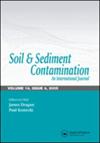不连续NAPL区域的水相渗透率
IF 1.5
4区 环境科学与生态学
Q4 ENVIRONMENTAL SCIENCES
引用次数: 1
摘要
在饱和土壤中,当毛细力大于相反的粘性力和浮力时,非水相液体(NAPL)会变成不连续的不动相。在发生这种情况的区域,水相渗透率小于周围介质的水饱和渗透率,这可能导致处理绕过目标污染区域。原位处理后,残余NAPL饱和度(Srn)降低,水相饱和度(Sa)和水相相对渗透率(kra)增加。因此,NAPL的原位处理必须考虑到不同程度的异质性。在本研究中,柱状实验测量了表面活性剂的应用过程中Kra‐Sa的变化,表面活性剂可以促进NAPL溶解到水相中。结果表明,随着Srn的降低,表面活性剂先降低kra,然后逐渐升高。在多相模型中,通常的做法是使用从压力-…本文章由计算机程序翻译,如有差异,请以英文原文为准。
Aqueous phase permeability in the region of discontinuous NAPL
In saturated soil, a nonaqueous phase liquid (NAPL) can become a discontinuous immobile phase when capillary forces are stronger than the opposing viscous and buoyancy forces. In regions where this occurs, the aqueous phase permeability is less than the water saturated permeability of the surrounding medium, which may cause treatment to bypass the targeted contaminated region. As an in situ treatment is applied, the saturation of residual NAPL (Srn) is reduced, while the aqueous phase saturation (Sa ) and the relative permeability of the aqueous phase (kra) increases. Hence, in situ treatment of NAPL must account for various levels of heterogeneity. In this study, column experiments measure Kra‐Sa during the application of a surfactant that enhances the dissolution of NAPL Into the aqueous phase. The results indicated that the surfactant initially decreases kra followed by a steady increase as Srn is reduced. In multiphase models, it is common practice to use empirical coefficients measured from pressure‐...
求助全文
通过发布文献求助,成功后即可免费获取论文全文。
去求助
来源期刊

Soil & Sediment Contamination
环境科学-环境科学
CiteScore
4.20
自引率
10.00%
发文量
53
审稿时长
2.2 months
期刊介绍:
When it comes to assessing and mitigating contaminated soils and sediments, there is no substitute for having the very latest tools, techniques and methodologies at your fingertips to help you deal with these issues efficiently and cost-effectively.
This is just the kind of essential expertise you’ll only find in Soil and Sediment Contamination . This internationally, peer-reviewed publication focuses on soil and sediment contamination from:
-Sludges-
Petroleum-
Petrochemicals-
Chlorinated hydrocarbons-
Pesticides-
Lead and other heavy metals.
Get detailed descriptions of all the latest and most efficient offsite and in situ remediation techniques, strategies for assessing health effects and hazards, and tips for dealing with everyday regulatory and legal issues. With the state-of-the-art tools that Soil and Sediment Contamination provides, you can successfully assess, mitigate, and solve both rural and urban soil contamination problems as efficiently and economically as possible.
 求助内容:
求助内容: 应助结果提醒方式:
应助结果提醒方式:


